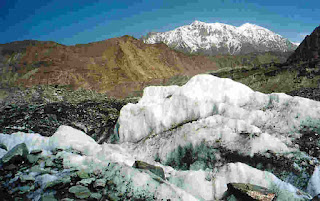Black Carbon and its Effects on Glaciers
Emissions from diesel trucks have a higher percentage of pure black carbon than the emissions from open fires.
These sources hold different amounts of black carbon, it depends on the type of soot they contain. Generally the blacker the soot, the more of a warming agent it is. Black carbon is a significant or strong light absorbing particulate matter in air pollution. Black carbon affects climate in two ways.
When deposited onto white surface of ice and snow, black carbon darkens it and reduces the surface albedo by absorbing significant sunlight (direct effect) and heats the surface which leads to melting of ice and snow.
Black carbon absorbs incoming sunlight as it is very effective in absorbing solar radiation and warms the surrounding air and as we know that warm air rises and expands, influencing the regional cloud formation and precipitation patterns. It causes atmospheric warming. It has a warming impact on climate 460-1500 times more than carbon dioxide but it has a very short lifespan, from a few days to a few weeks. Its effects on climate are strongly regional because of its short lifetime in the atmosphere. It can be removed quickly from the atmosphere if its emissions are reduced.
Black carbon is a primary component of fine particulate matter (PM2.5) in air pollution. It is a climate forcing agent as having the second largest contribution to global warming after carbon dioxide. But unlike CO2 it persists only for a short duration in the atmosphere before it descends with rain on the Earth.
Indoor sources of black carbon are candles and cookstoves while vehicular traffic and forest fires and burning on agriculture waste are the outdoor source. Humans are exposed to black carbon by inhalation of air in the proximity of sources. Premature mortality has been linked with black carbon pollutants by a study conducted by IIT, BHU.
Several cities located in the Indo-Gangetic Plains (IGP) are found among the most polluted in India as well as in the world. One of the reasons behind this is that the Indo-Gangetic Plains has a high concentration of black carbon with the largest contributor to black carbon emissions (in India) having serious implications on the climate of the region as well as human well-being.
India is the second largest emitter of black carbon in the world. The United States accounts for about 6% of black carbon emissions while India and China together are responsible for 25-35% emissions. Developing countries are major emitters of black carbon and account for the majority of black carbon emissions.
Black Carbon and Glacier Melting on the Mountainous Regions
There are almost 55,000 glaciers in the Himalaya, Karakoram and Hindu Kush (HKHK) mountains ranges and most of them (around 80%) are the source of the Indus, Ganga and Brahmaputra rivers.
The glaciers in the Hindu Kush Himalayan (HKH) region are melting at a faster rate than the average global ice mass due to deposition of black carbon onto snow and ice surfaces, making them able to absorb more incoming sunlight and heat up, resulting in acceleration of glaciers melting.
These Glaciers in the HKH region are the major source of freshwater for the perennial rivers in the Indo-Gangetic Plains. Reduction in the glaciers in the HKH region would definitely affect lives and livelihoods of people in mountains and downstream areas as they affect water availability, agriculture, ecosystems and infrastructures. Glacier melt produces flash floods, landslides, soil erosion and Glacial Lake Outburst Flood (GLOF).
Black carbon concentrations near the Gangotri glacier rose 400 times in summer due to forest fires along the Himalayan foothills or slopes and stubble burning in agriculture fields in the western part of India has triggered glacier melting, as per the study of Wadia Institute of Himalayan Geology. This seasonal increase in concentration of black carbon to some extent is also contributed by long-range transport vehicles during winter.
Glaciers in the Laddakh's Drass region have been receding at a faster pace since the last two decades. It is because the growing vehicular traffic led to increased black carbon concentration in the region, according to the study of Environmental Science and Pollution Research.
Black carbon is significantly responsible for Arctic warming (around 30%) and hence contributes to the Arctic sea ice melting. Decline of the Arctic sea ice leads to more rapid Arctic warming and possibly irreversible climate change.
Black Carbon Concentration Over the Indo-Gangetic Plains
Black carbon concentration over IGP is found to be highest during the winter season and Fog and low visibility across the Indo-Gangetic Plains prevails this time. There are basically two reasons for it.
- Paddy stubble burning during winter in North India particularly in Punjab and Haryana and low-temperature over the IGP during winter leads to very shallow mixing depth resulting in higher concentration of pollutants in the lower atmosphere and hence higher concentration of BC over the IGP.
- The burning of wood and cow dung cakes as cooking fuel is another major source of black carbon in the IGP.
Temperature gradually increases over North India and IGP as winter season comes to end. During pre-monsoon time (March to May), vertical mixing of pollutants takes place in the IGP due to temperature rise. As a result, the concentration of black carbon starts decreasing at this time and the onset of rainfall significantly reduces the BC over IGP due to wet scavenging.
How does the Black Carbon emissions Over IGP affect Glacier Melting in HKH Region?
The emissions in the Indo-Gangetic Plains rise into the air as temperature increases during pre-monsoon and get transported over long distances by monsoon winds (during monsoon) blowing from South Asia and these emissions are responsible for much of the black carbon deposits over the Himalayan regions and southern Tibetan plateau. Black carbon falls on the snow surface along with precipitation. Accumulation of black carbon is accelerating the melting of glaciers in the Himalayan region as it absorbs the significant sunlight and raises the surrounding air temperature; it is a direct effect of black carbon.
Sometimes these mountainous regions also get black carbon from far away regions such as Africa due to biomass burning and the Middle East due to burning of fossil fuels as emissions from these regions get transported by prevailing winds.
Northern and eastern parts of the Tibetan plateau receive much of their black carbon from Central China and Karakoram range receive a large amount of black carbon from emissions in the Middle East, Europe and North Africa.
Haze layers are found to be in existence during winter and spring season which extends into more than three kilometers above the earth's surface vertically and also extends into the Himalayas foothills horizontally. Black carbon in the upper part of the layer absorbs significant sunlight and warms the air and reduces the amount of sunlight reaching the earth surface below the haze layer resulting in lowering the temperature in valleys and lowland areas and thus cools them. This is the cooling effect of black carbon. This phenomenon contributes to increased fog and low visibility in river valleys and over the Gangetic Plains.
The reduced sunlight affects the photosynthesis and hence leads to decreased crop yields. People light the fires to keep warm and contribute to extended persistence of fog through the indirect effects. The air heated by black carbon in the upper parts of the haze layer would come in contact with the high mountains and warm them. This appears to be one of the reasons for rapid temperature rise at high altitudes, contributing to further glacier melting in the Himalayas region. The effects of black carbon in the mountain areas is completely different, compared to the effects on the Earth surface lie beneath the haze layer.
Effects on Monsoon
Black carbon affecting monsoon patterns in the HKH region.
Black carbon aerosols affect the cloud formation, temperature and influence the rainfall patterns substantially.
Black carbon might reduce the thermal gradient between land and sea because of its cooling effects and as a result of that strength of circulation would be reduced.
Due to warming effects of black carbon in the upper atmosphere, warm air over the foothills of the Himalayas might drive stronger convection which results in the increased incidents of high rainfall or simply, Black carbon aerosols in the IGP also led to increased incidents of high rainfall in the foothills of the Himalayan Region.
Black carbon aerosols produced in South Asia can be transported across the Himalayas region to the inland Tibetan Plateau and severely affected the mass gain of the Plateau glaciers by changing long-range water vapour transport from south Asian monsoon region. Decreased precipitation in the Tibetan Plateau, especially in the southern Tibetan Plateau leads to decreased mass gain of glaciers.
Impact on Vegetation And Soil
Black carbon influences the formation of clouds and affects the photosynthesis process by blocking the sunlight thereby inhibiting the plant growth. It also influences air circulation and rainfall patterns.
Black carbon contributes positively to the tropical soils by absorbing the important plant nutrients, hence enhancing soil fertility.



This article contains a great deal of significant data. I'm stunned by the nature of the data and furthermore it is a helpful article for us, Thanks for share it.Commercial Waste Collection Kent
ReplyDelete